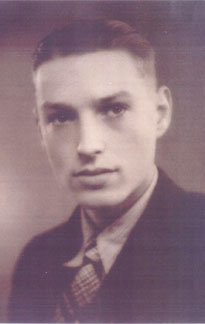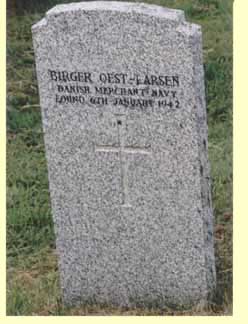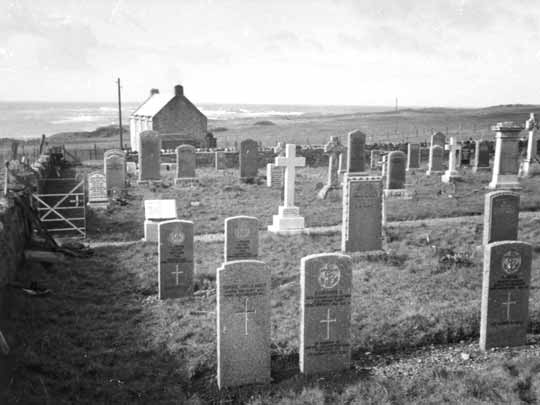There is a headstone in the churchyard at Kilchattan on the Isle of Colonsay, off the southwest coast of Scotland. It reads:
Birger Oest-Larsen
Danish Merchant Navy
Found 6th January 1942Birger Oest-Larsen, born October 15, 1920 in Odense, Denmark, was mate on SS Crusader, torpedoed in the North Atlantic on November 14, 1941. The attack on the Crusader is listed as occurring in Grid BD 1542 on German naval charts.
Oest-Larsen was found 54 days and more than 1,200 miles away from the probable site of the sinking.
A researcher documenting Colonsay's war graves and casualties provided a photo obtained from Oest-Larsen's family in Denmark, photos of the headstone, graveyard, and some details.
The place Oest-Larsen was found is called Port an Obain. His body was on the land side of a stone wall, several yards above the high tide mark of a pebble beach. The researcher visited the location and thought it extremely improbable that a body could have been thrown by a wave that far up from the waters edge and behind a wall. Local residents recall that the body was still warm when it was found, thus it appears he was alive when he came ashore, but unfortunately, died before being found. Local residents gave him a proper burial.
Birger Oest-Larsen survived fifty-four days in a lifeboat in November and December in the frigid North Atlantic, only to die shortly after crawling ashore.
During World War II, a considerable number of sailor's bodies were found along the western shores of Colonsay. Many had boots tied around their necks as if they had bailed out from a lifeboat rather than risk being dashed against the rocks. Some had obviously been dead only a short while.
Birger Oest-Larsen, 21, mate on SS Crusader Birger Oest-Larsen
Danish Merchant Navy
Found 6th January 1942
Graveyard at Kilchattan on Isle of Colonsay. Oest-Larsen headstone front row, left
Map of North Atlantic showing assumed origin of voyage, location of sinking of SS Crusader, location of body of Birger Oest-Larsen Island of Colonsay located off the southwest coast of Scotland SS Crusader
The Ship Requisition Act signed into law on June 6, 1941 allowed the U.S. government to seize 84 foreign ships voluntarily interned in American ports. Among them were forty ships flying the flag of Denmark, their seamen preferring not to return to their Nazi-occupied homeland.
The U.S. Maritime Commission reflagged most of these ships in Panama, "our sister Republic," in the words of President Franklin D. Roosevelt. There were several reasons for this. First, many of these ships did not meet U.S. Coast Guard requirements. Second, according to the Merchant Marine Act of 1936, U.S. flag ships had to be crewed by Americans, and this would have left foreign seamen familiar with these ships sitting idle ashore. Third, the Neutrality Act forbade aid to countries that were at war, yet President Roosevelt wanted to send supplies to Great Britain.
Most of these ships were old rustbuckets, but someone at the Maritime Commission with a wry sense of humor renamed many of them in honor of famous racehorses.
Casualties among these ships were horrific. They crossed the North Atlantic early in the war when sinkings were at their peak. They suffered breakdowns and had to drop of out convoys, falling prey to the sea-wolves that awaited stragglers. Some ships made the suicide run to Murmansk.
Several of these ships were sunk before December 7, 1941, all in the North Atlantic:
August 17, 1941 Longtaker [former Danish Sessa]
September 11, 1941 Montana [former Danish Paula]
September 19, 1941 Pink Star [former Danish Landby]
October 16, 1941 Bold Venture [former Danish Alssund]
November 11, 1941 Meridian [former Italian Dino]
November 14, 1941 Crusader [former Danish Brosund]Crusader, the 1926 Horse of the Year, was a chestnut thoroughbred colt sired by the legendary Man o' War. His name was given to a ship built in 1916 as the Yesaki Maru by Osaka Iron Works, Osaka, Japan. As she changed owners, her name changed: General Wergeland, Aslaug, Winneconne, Danevirke, and Brosund. Brosund, managed by T.C. Christensen, called Fredrikshaven, Denmark her home port. She was a coal-burner, 2939 tons, 314 feet long, 43.75 feet wide and had a top speed of 9.0 knots. Definitely not a sleek thoroughbred!
Brosund was interned in Baltimore on November 12, 1940 and renamed Crusader under the Panama flag in 1941. United States Lines out of New York was designated her operator for the U.S. Maritime Commission.
Crusader was assigned to Convoy SC53 that formed in Sydney (Cape Breton), Nova Scotia, Canada. "SC" was the designation for "slow" 7.5-knot (8.6-mph or 13.9-km/hr) eastbound convoys, created for ships that could not manage to keep up with the "fast" 9.0-knot "HX" convoys. Convoy SC53, comprising 52 ships, left Sydney on November 4, 1941.
According to some sources, Crusader was last heard from on October 10, 1941 and never joined the convoy formation at the rendezvous. Other sources say she straggled from the convoy. Crusader was torpedoed and sunk in the North Atlantic on November 14 at 3:37 AM GMT, by U-561, commanded by Robert Bartels. The same U-boat sunk another "racehorse" straggler from SC53, SS Meridian, on November 11, just to the northeast.
I have never been able to ascertain the exact number of crew aboard, but typically, a ship of this size carried about 33. There was one survivor: Edward Barreto, a coal passer from Rio de Janeiro, Brazil, who was a Prisoner of War at Marlag und Milag Nord, Hanover, Germany. He was eventually released. I have been unable to find out how he became a prisoner of war, but guess he might have been rescued by U-561 and taken to Germany.
Thus far, I have the names of 21 of the crew who died: 15 Canadian, 1 Dane, 4 Norwegian, and 1 American.
Survivor SS Crusader (Prisoner of War at Milag Nord)
Last First Position Hometown Homestate Barreto Edward Messman Rio de Janeiro BRAZIL Mariners Killed SS Crusader
Last First Position Hometown Homestate Andersen Rolf Harry 1st Engineer Notteroy NORWAY Bradshaw Robert Radio Officer Toronto Ont CANADA Carriere Armand Fireman Unknown CANADA Gamelin Ernest Fireman Montreal Que CANADA Gavlen Kristian Asbjorn Master Sandefjord NORWAY Godin Ralph A.B. Unknown CANADA Hay Robert Chief Mate Manningtree Essex GREAT BRITAIN 32 Henderson Reginald 3rd Engineer Montreal Que CANADA Horowitz Oskar Fireman Cambridge MA Jensen Trygve Kristian O.S. Tveit NORWAY L'Abbe Arthur Fireman Lecleroville Que CANADA Laird Robert Utility Verdun Que CANADA Lister William A.B. Unknown CANADA Meddin Theodore Fireman Unknown CANADA Moon James Oiler Owen Sound Ont CANADA Oest-Larsen Birger Mate Odense DENMARK Portal Bernard Oiler Unknown CANADA Sharp George O.S. Montreal Que CANADA Skjerven Hans Olaus Engineer Oslo NORWAY Sparks Lloyd Fireman Hamilton Ont CANADA Sylvester Albert Steward Unknown CANADA Theriault Maurice Messman Unknown CANADA [We would appreciate additional information.]
Sources:
Hague, Arnold. The Allied Convoy System 1939-1945: Its Organization, Defence and Operation. Annapolis MD: Naval Institute Press, 2000
Jordan, Roger, The World's Merchant Fleets 1939: The Particulars and Wartime Fates of 6,000 Ships. Annapolis, Maryland: Naval Institute Press, 1999
Rohwer, Jurgen. Axis Submarine Successes of World War Two. Annapolis, Maryland: Naval Institute Press, 1999
Map of Atlantic Ocean adapted from http://www.exxun.com/AtlanticOcean/b_mp.html
Map of United Kingdom adapted from http://www.lib.utexas.edu/maps/europe/united_kingdom_rel87.jpg
Lloyd's Register of Ships from 1930 to 1945
Canadian Merchant Navy Database Veteran Affairs Canada
Sjomennes Minnehallen i Stavern Norwegian Seamen's Memorial
Personal correspondence from Alan Davis
http://en.wikipedia.org/wiki/Crusader_(horse)
President Franklin Delano Roosevelt: A Message to the Congress Asking Power to Requisition Idle Foreign Ships in American Waters. April 10, 1941
Acquisition of Domestic or Foreign Merchant Vessels, Public Law 101, [H.R. 4466] June 6, 1941
Appeal to Danish Seamen to Remain Aboard their Requisitioned Vessels
Foreign Passenger and Cargo Ships Taken Over by U.S Maritime Commission during World War II
President Franklin Delano Roosevelt Fireside Chat to the Nation, September 11, 1941
Merchant Mariners at Milag Nord Prisoner of War Camp in Germany during World War II
04/07/08 Revised 01/05/2010
www.USMM.org ©1998 - 2010. You may quote material on this web page as long as you cite American Merchant Marine at War, www.usmm.org, as the source. You may not use more than a few lines without permission. If you see substantial portions of this page on the Internet or in published material please notify usmm.org @ comcast.net




